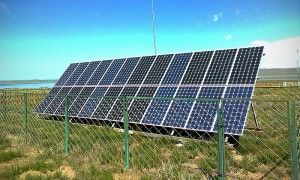California Enviro Policy Goes Schizo
By DAVE ROBERTS
California’s energy utilities have been ordered by state officials to provide one third of their energy from renewable sources — solar, wind and geothermal — by 2020. But in a green Catch 22, California’s government places numerous roadblocks in the way of those utilities, making it more difficult — and more expensive — to achieve the 33 percent renewable energy goal.
Several energy providers complained about those roadblocks at a California Energy Commission workshop this week dealing with the transmission infrastructure needed to get the power from the windmill farms and solar arrays to urban areas. There are currently $7 billion worth of proposed transmission projects in the planning pipeline — more than enough to meet the goal of generating 8,000 megawatts from renewable sources.
But it can take as much as 12 years for those projects to be approved and constructed, according to Michael Picker, Gov. Jerry Brown’s renewable energy advisor. “That’s the worst case, but it’s a reality,” he said. “We need to plan better, execute better. Otherwise it just won’t work. That’s one of the significant challenges we hope to find out solutions for.”
The Sunrise Powerlink is a 117-mile, $1.9 billion transmission line from Imperial County to San Diego that will provide enough energy for 650,000 homes when it goes online next year. It required 11,000 pages of environmental reports (the largest in California history) and took four years to go through the regulatory review process involving more than 43 public agencies.
One of the problems is California’s Soviet-style planning structure.
“This isn’t a market-driven approach, this is a centralized planning approach,” observed Tony Braun, counsel for the California Municipal Utilities Association. “It’s two or three entities that are going to call balls and strikes as to what are the favored projects, the generators that get contracts and routes. We are socializing the transmission costs and trying to decide the priorities of projects that get done and declaring winners and losers.
“Why not put the most emphasis on the projects that can get done fastest and cheapest? We are calling balls and strikes anyway. Why not say these are the best to do now? We can’t do them all at the same time. This will leave certain projects on the side of the road. But I don’t know other ways where we can get through this roadblock.”
Doubling Energy Costs
The numerous studies, hearings, other red tape and delays create a bottleneck and drive up energy costs, which could double by 2020.
“I shake my head as a guy who has been doing this for 25 years that something is missing,” said Ziad Alaywan with the ZGlobal engineering firm. “I don’t know what’s going on behind the doors. I look at the results and it’s very questionable. We are not doing transmission planning the way I know it should be. It’s basically you should look at alternatives and pick the least costly. We are not doing that.
“If you look at Texas, the process there works very well. They study different scenarios, look at economics, land use and put it out to bid. I don’t know why it’s so complicated in California. The politics are very heavy in this. What this is leading to is very high costs for everybody. There is a lot of improvement that can be made to the process. We have to find a way. Are we going to accept this regime that we have today, which is leading to higher costs, or come up with something that is more integrated planning?”
Byzantine Bureaucracy
Dariush Shirmohammadi, with the California Wind Energy Association, also complained about California’s Byzantine bureaucracy. “In California no one has the authority to have a transmission project built, but everybody has the ability to kill it,” he said. “Entities in California involved in planning and permitting tend to repeat each other’s work. Sometimes they take on an activist role. Everything done by another entity has to be repeated and questioned and everything gets slowed down.”
Ironically, it’s environmental groups placing a lot of the roadblocks in the way of supposedly environmentally correct projects. They need to be brought in much earlier in the planning process so that their concerns can be addressed ahead of time, said Shirmohammadi. He also cautioned, “I’m not sure how successful we’ll be in bringing transmitters and environmental groups together without somebody committing murder.”
Ultimately, it’s the consumers who get stuck with the tab. But they’re not involved with the planning process, which is run by bureaucrats at the behest of special interest-driven politicians.
Working the System
Most companies try to adapt to the bureaucracy rather than fight it. One adaptation is to put projects that are still on the drawing boards into the planning process before they’re ready, according to Robert Jenkins with First Solar, Inc.
“What we see today is the planning in California is sending out mixed messages,” said Jenkins. “The incubation time is so long it requires immature projects to get into the queue. Get in early, get your allocation and then you try to mature your project. We need to think about reversing that. But then the process needs to move quickly.”
Another mixed message solar companies receive is where they should place their panel array, said Jenkins: “We like to use private, disturbed lands. It is not easy. They tell you to go to public lands. Public lands tell you to go to private lands.”
Jon Eric Thalman, with Pacific Gas and Electric, provided a clothing analogy for the way the renewable energy process should be done: “Our effort as a state to get to where we want to go with our (renewable energy) goal is putting on a shirt first with the button holes correct. If we don’t look at the whole picture, we may be putting the wrong buttons in the wrong holes. It looks like we’ll be able to get 33 percent renewable energy connected to the grid. Those are the first couple of button holes. We need to focus on where we are in the big picture. When we get to the bottom of the shirt, will we be matched up?”
It remains to be seen whether California residents will be losing their shirts when the higher energy bills arrive in the mail due to the additional costs of renewable energy. The 33 percent target by 2020 is just the beginning.
Gov. Jerry Brown, in his signing statement for the mandate, said, “[I]t is really just a starting point — a floor, not a ceiling. Our state has enormous renewable resource potential. I would like to see us pursue even more far-reaching targets. With the amount of renewable resources coming on-line, and prices dropping, I think 40 percent, at reasonable cost, is well within our grasp in the near future.”
Related Articles
AB32's echoes failed policy
JUNE 16, 2010 By JOHN SEILER Industrial policy is defined as government “policies that stimulate specific activities and promote structural
Go Tigers!
Oct. 24, 2012 Sorry, California, but I’m rooting for the Detroit Tigers in the World Series. They’re my home team.
Push begins to overturn new California gas tax
A fresh effort has been launched to reverse Gov. Jerry Brown’s fuel and vehicle tax deal, passed narrowly in Sacramento on




